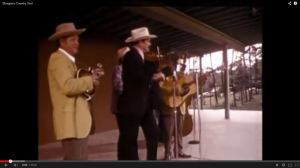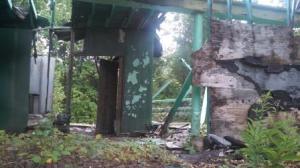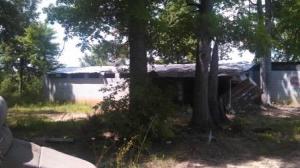By Art Menius, August 31, 2014
Barnum-like music promoter and artist manager Carlton Haney produced the first three-day bluegrass music festival with camping on Labor Day weekend 1965 on Cantrell’s Horse Farm near Fincastle, Virginia. Haney combined his and Bill Clifton’s idea of a big show with all the top bluegrass artists with the concept taken from Newport Folk Festival of a curated, multi-day festival offering some kind of narrative. Carlton capped off the three days with the “Blue Grass Story” on Sunday afternoon, creating a narrative arch for the community that brought the string tribe together. This was folklore being constructed on the ground. View 11 minutes from that first festival here,
After a second year in Fincastle, the original bluegrass festival moved to Watermelon Park near Berryville, Virginia for another two years. On Labor Day weekend 1969, the original festival arrived near Haney’s hometown of Reidsville, NC. On land besides Pat and Hazel Smith just south of Cherry Grove Road on the western edge of Caswell County, NC, Carlton built Blue Grass Park, the prototype for bluegrass festival venues for the next score.
There Carlton enjoyed his glory years, promoting bluegrass as a gospel, publishing Muleskinner News, telling the story, using up almost every ounce of energy Fred Bartenstein had. The theatrical documentary, Bluegrass Music, Country Soul, captured the third, 1971 festival. He added events there including the spring New Grass Festival, while also presenting famed festivals in Gettysburg and Berryville. By the late 1970s competition had grown fierce, while Carlton’s physical, mental, and financial health declined. Mike Wilson and John Maness helped promote three or four very presentable Labor Day weekend festivals during the middle 1980s, before the pair moved the event to Maness’ park.
At one of those events, Carlton took me up the house, still standing on site, which already looked as if vandalized in 1986. Painstakingly, while he was supposed to be stage managing, Carlton located each issue – in order from Vol 1, No 1 – in the chaos. He seemed to have maintained every check book he had ever owned, including banks long out of business. Meanwhile, Maness and the Bass Mountain Boys had been on stage for 75 minutes with no stage manager to wake up the emcee, Bill Hill. When Carlton return to livid Maness, Haney responded, “Art, show John what I gave you! The whole history of bluegrass music.”

Camp Springs stage in 1971, still from Bluegrass Music, Country Soul with Lilly Brothers and Tex Logan
The Saturday of Labor Day Weekend 2014, my wife Becky Johnson decided we should head up to Camp Springs for the 45th anniversary and see if we could still find Blue Grass Park. It did not prove easy. First, I made the mistake of turning off of Cherry Grove Road on to Camp Springs Road and driving fruitlessly up its 2 miles thrice. Finally back on Cherry Grove east bound, both Becky, who had only been there twice, and I felt drawn to turn right on Boone Road. After a couple of passes looking for the “Blue Grass Park” sign that was still hanging in the 1990s, we pulled up to a lonely gate with several no trespassing signs.
I had feared a trailer park. What we found was kindly worst. We followed the remains of the entrance road, passed a pine thicket where the band vehicles used to park between Boone Road and the stage area. Turning the corner, feeling like seekers of lost Mayan temples in the jungle, we faced heavy woods, thick underbrush, and to the right of an area where trash had been burned and cans and bottles dumped, stood the Carlton’s old bathhouse. Numerous no trespassing and one “Dead Man Walking if I Catch You Here” messages decorated the cinder block walls. Becky saw a sign warning of “Boobee” traps. The thought of a cannabis plantation crossed my mind.
We pushed through widespread poison ivy and briers as if no deer or other wildlife cleared the brush out in what was once the seating area. Finally like a red clay Angkor Wat, the remains of the stage, one so many festivals copied, stood before us in tatters. Where thousands saw New Grass Revival for the first time, where Tony Rice jumped ship from Bluegrass Alliance to J.D. Crowe, where Carlton told the Blue Grass Story, where Bill Vernon and Fred Bartenstein emceed, looked like a burned out mobile home. Carlton doing an impromptu version of the story with Mac Wiseman, Lester Flatt, and Chubby Wise at Renfro Valley, KY in 1971 can be seen here.
Something of “Kathaleen’s” Kitchen could be seen in the distance. More adventurous than I and possessing two good knees, Becky
took off through the underbrush and pine trees. She found a logging that took her to Carlton’s old house and the pond behind the stage.
We drove on to Milton, NC. We talked about Caswell County’s need for more tourism attractions and how Blue Grass Park reminded us of the once-overgrown Historic Occaneechi Speedway looked in Hillsborough, NC before citizens took action together to restore it. As many bluegrass music devotees are exist, cannot Carlton’s Blue Grass Park be saved in cooperation with Caswell County Economic Development and the Caswell County Historical Association to created a living historical site that tells the bluegrass music story while presented concerts and festivals.
-30-











